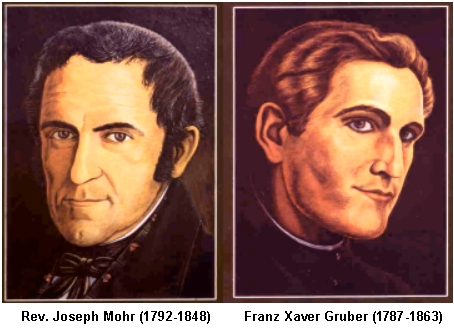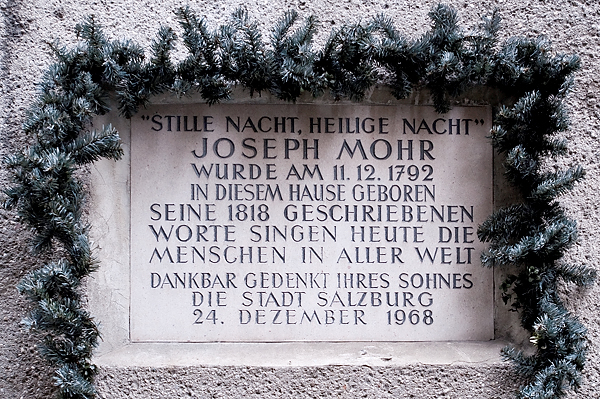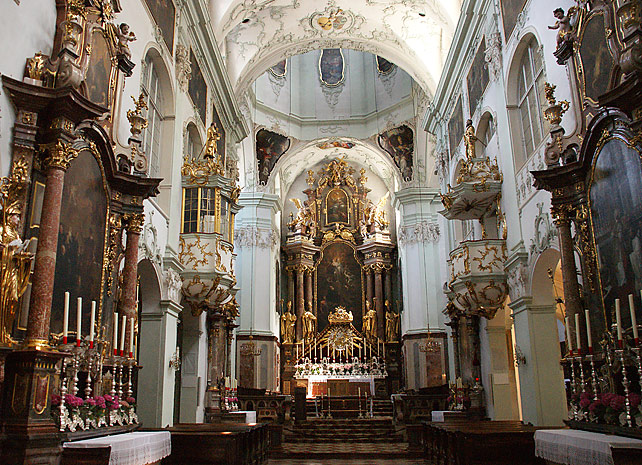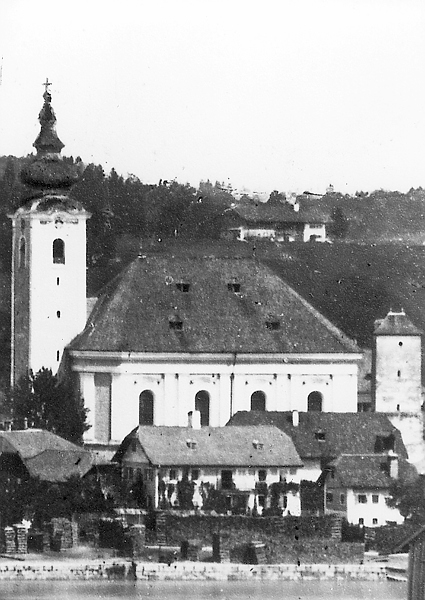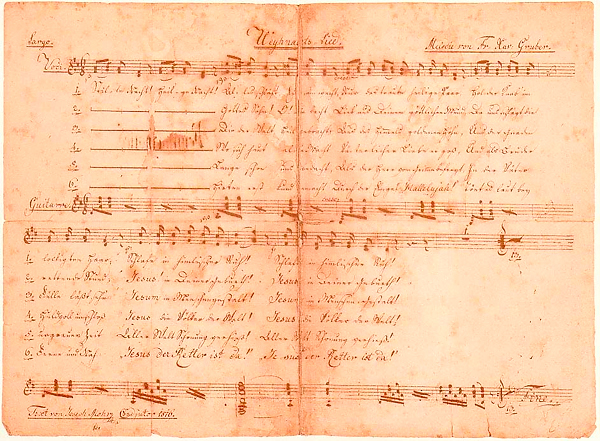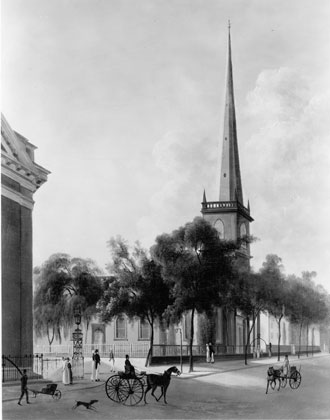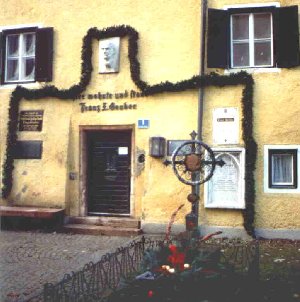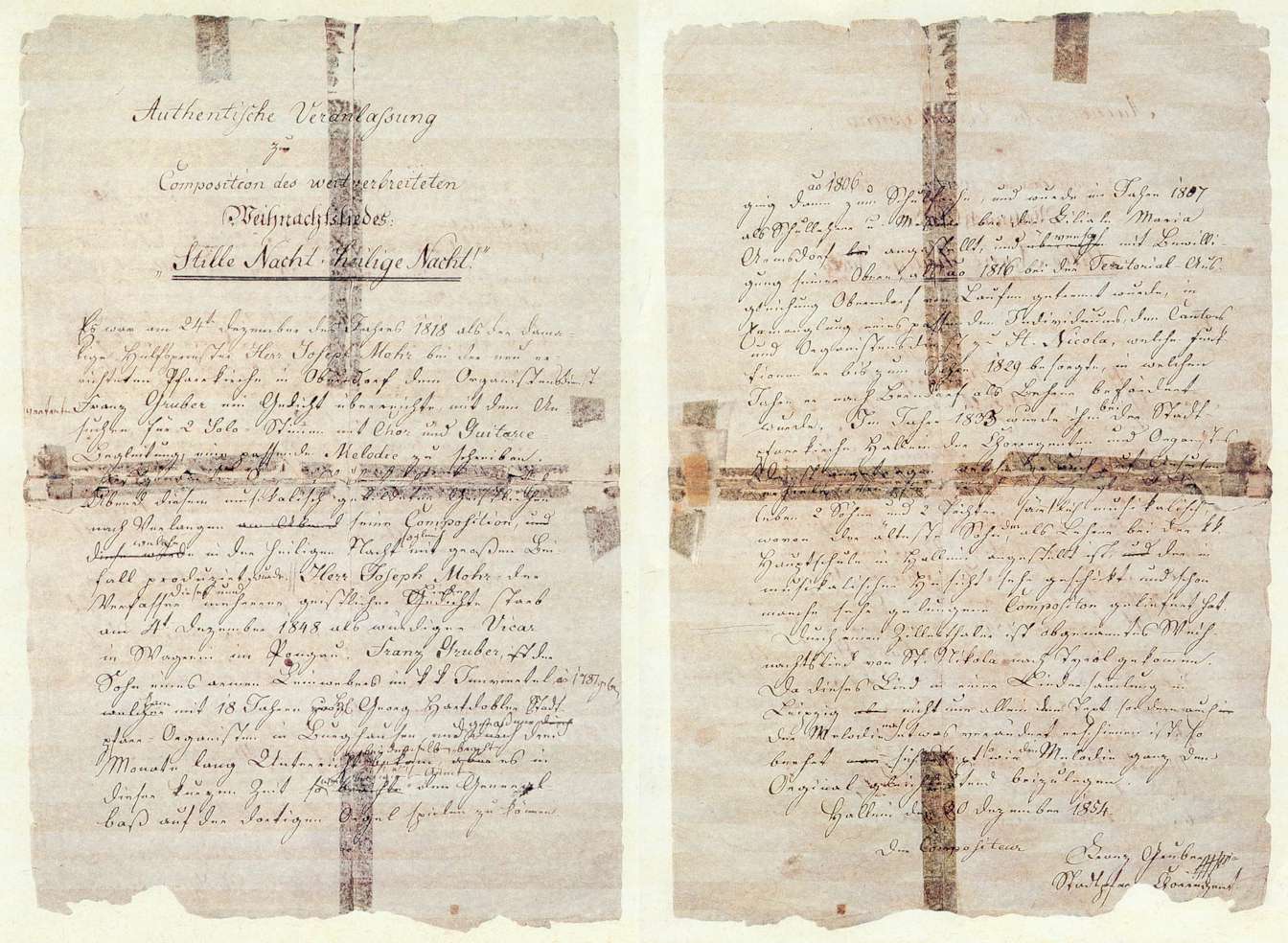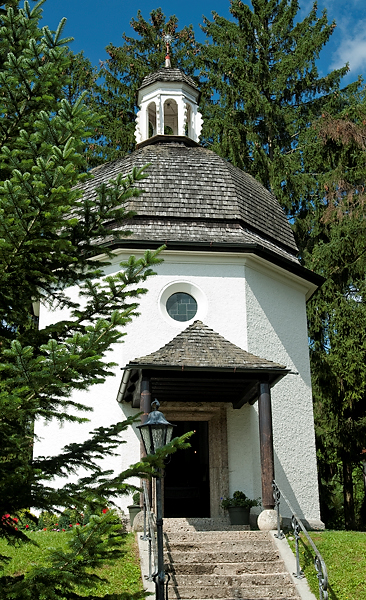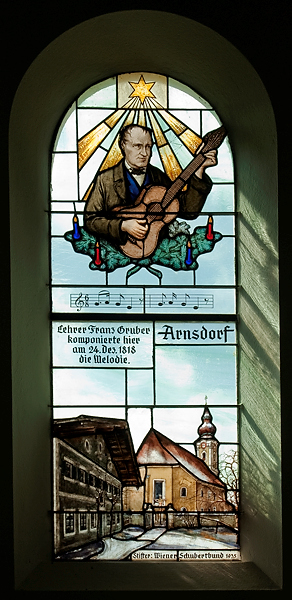Joseph Mohr (left, text) the parish priest at St. Nicholas Church in Oberndorf, Austria; and Franz Xaver Gruber (music), a local school teacher and the church organist. The two good friends co-wrote ‘Silent Night, Holy Night!’The Story of ‘Silent Night’
By Dr. David Nelson
The world's most beloved Christmas carol, “Silent Night,” comes from the small Austrian village of Oberndorf, just north of Salzburg. On Christmas Eve, 1818, the congregation of St. Nicholas Church heard the first performance of this wonderful music. Since then, “Silent Night” was been translated into hundreds of languages and sung and played in every corner of the globe. Here’s the story of its origin and how it was spread to the rest of the world, which embraced it as a seasonal sacred standard.
Joseph Mohr and Franz Gruber
“Silent Night” was the collaboration of two good friends. Joseph Mohr, who wrote the text, was the young parish priest at St. Nicholas Church, and Franz Xaver Gruber, who composed the music, was a local school teacher and the church organist. Here is how they got to Oberndorf.
Joseph Mohr was born on December 11, 1792 and baptized in the Salzburg's famous Cathedral a few hours later. For years his birth home was thought to be Steingasse 9, but in 1998, a historian determined that the actual birth house was on the site of today's Steingasse 31.
Unfortunately visiting these sites today is problematic: the actual birth house was destroyed in World War II and there is still a memorial plaque at the wrong address!
For more than two centuries years, people thought Joseph Mohr
was born in the building where this plaque
hangs. He was actually born about one
hundred meters away.The future priest's childhood was not a happy one. His father, Franz, was a soldier in the army of the prince-archbishop of Salzburg and was away from home most of the time. His mother, Anna Schoiber, was quite poor, and Joseph was the third child that she had out-of-wedlock. Even his godfather was not a happy figure in the child's life because he was Salzburg's executioner.
Life only began to improve for the child when the cathedral's curate took Joseph as a foster child. The boy showed an affinity for music and began to sing in the choirs of St. Peter's Church and the University Church. As he grew, Mohr continued to flourish, first as a student at a well-known grammar school in Kremsmüster in Upper Austria, and later the archiepiscopal seminar in Salzburg. His ordination was on August 21, 1815, and one of his first posts was at Oberndorf from 1817 to 1819. There he met Franz Gruber.
The interior of St. Peter’s Church in Salzburg, where the young Joseph Mohr sang in the choir.Gruber was born on November 25, 1787 in the village of Unterweizberg in Bavaria near the beginning of the Salzach River. His father was a poor weaver who believed his son should learn a useful trade and resisted young Franz's desire to learn music. This did not deter the boy, who, unbeknownst to his father, took violin lessons and also helped the organist at his church. When the father finally heard Franz's organ playing, he relented and allowed his son to study to be a teacher. In 1807, Franz became schoolmaster and organist in the town of Arnsdorf, near Oberndorf, and in 1816 he became the organist in at St. Nicholas Church. The two principal figures of “Silent Night” were now in the same town.
The Story of ‘Silent Night’: The Origin of the Hymn
With such a beloved piece of Christmas as “Silent Night,” it is not surprising that there are many stories of how it came to be. Although some of these are lovely tales, most are works of romanticized fiction. After studying as many reliable sources as i could find, including many at Oberndorf, I am quite confident that what follows is what we actually know about its composition.
On December 24th, 1818, Father Joseph Mohr walked over to Franz Gruber's home. He asked the organist to take a Christmas poem the pastor had written two years earlier and set it to music. Mohr and Gruber would sing the melody, the choir would join in, and the accompaniment would be for solo guitar played by Mohr himself. Years later, Gruber's own words describe the result. "On the very same evening, [I] fulfilled the musical curate's request and [the] simple composition was immediately performed on the holy night to the acclaim of everyone present." ‘Silent Night’ was born.
An old photo of St. Nicholas Church, where ‘Silent Night’ was first performed on Christmas Eve, 1818. The church was razed in 1906.No one knows why Mohr wanted this music to be written, or even why he wrote his six-stanza poem in 1816. Many have speculated that the church's organ was broken, but there are no records to support this. Perhaps Mohr wanted to play his guitar or even just desired to hear something new. One of the more delightful tales was that mice ate through the organ's bellows, making the instrument unplayable.
The Story Of Silent Night: Spreading The Hymn To The World
How “Silent Night” spread to the rest of the world is an interesting story in and of itself. In 1819, the master organ builder Karl Mauracher came to St. Nicholas Church to work on the organ. (Perhaps this is why some have thought the organ was not functioning on Christmas Eve, but we don't know this for sure.) When he left, he probably took the first copy of “Silent Night” with him when he returned to his home in the Zillertal (near Innsbruck).
An early copy of ‘Silent Night,’ in Joseph Mohr’s handOutside of Oberndorf, the music found its way to two musical families: the Rainer's and the Strasser's. The Rainer's sang it on Christmas Eve 1819 in their church in Fügen, and three years later performed it for Tsar Alexander I of Russia and Emperor Franz I of Austria. They also gave the first performance of “Silent Night” in the United States outside of Trinity Church in New York in 1839. The Strasser's were a family of glove makers who were also fine singers. Each year, they traveled to German fairs to sell their gloves and often sang to entertain the shoppers. A Leipzig newspaper reported that the Strasser's sang “Silent Night” at one of these fairs in 1832.
Trinity Church in New York, outside of which the
first U.S. performance of ‘Silent Night’ was held in
1839. This drawing depicts the church as it was in
that year. The church that stands on the site today
was consecrated in 1846.By the middle of the 1800s, the music was well known and well loved, but its authorship was unknown. To determine who actually created this hymn, the Royal Prussian Court Chapel in Berlin contacted the Benedictine Monastery in Salzburg to ask who might have written Silent Night. In 1854, word of this got to Franz Gruber, and he wrote a two-page document entitled the Authentic Reason for the Composition of the Christmas Song ‘Silent Night, Holy Night.’ In it, Gruber presented a brief history of the origins of the work and named himself and Mohr as its creators.
Following their collaboration in 1818, the Mohr and Gruber went their separate ways. Gruber continued to serve as organist for St. Nicholas Church and as teacher in Arnsdorf until 1829, when he moved to Berndorf to serve in a similar capacity. It was not until 1835 that he fulfilled his career dream of being solely a musician when he became the choir director, singer, and organist for the parish church in Hallein. He lived there until his death in 1863.
Mohr left Oberndorf in 1819 and then worked in a number of churches. His longest positions were in Hintersee (ten years) and Wagrain (eleven years), where he died in 1848.
Gruber’s grave and museum in HalleinEven after “Silent Night” had become well known in Europe, no one knew who composed it. Authorities in Berlin began to search its creator, and contacted the Benedictine Monastery in Salzburg. Franz Gruber was contacted and wrote the following document to finally verify that he and Joseph Mohr had written the famous hymn. This is the only statement about the Christmas carol to come from either Gruber or Mohr. Gruber probably wrote it quickly, and spent more time talking about himself than about his collaborator!
Authentic Reason for the Composition of the Christmas Song ‘Silent Night, Holy Night!’
On December 24th in the year 1818 the curate of the newly erected parish-church St. Nicola of Oberndorf, Mr. Joseph Mohr handed over a poem to the deputy organist, Franz Gruber (at that time also teacher at Arnsdorf) with the request to compose a suitable melody for two solo voices with choir and the accompaniment of one guitar.
The latter handed his simple composition over to the musically trained clergyman as requested--an exact copy of the original is attached hereto--his composition was produced immediately on Christmas Eve with great applause.
Mr. Joseph Mohr, the originator of this, and other spiritual poems, died on December 4, 1848, the worthy vicar at Wagrain in Pongau.Franz Gruber, at present choir-conductor and organist at the parish-church of Hallein, who is the third son of a poor linen-weaver, born at Hochburg in the year 1787; after leaving the weaver's loom was apprenticed at the age of 18 to H. Georg Hartdobler, who was parish-organist at Burghausen. After only three months study he attained such proficiency to be able to play the organ at high mass.
In the year 1806 he switched over to teaching and was employed as teacher and curate the following year at the school of Arnsdorf. From there, after the separation due to territorial changes of the suburb of Oberndorf from the town of Laufen, with the approval of his superiors he took up the organist and choir duties at St. Nicola until the year 1829, when he was promoted to the position of a schoolteacher of Berndorf.
In the year 1833, a vacancy for a choir-conductor and organist at the parish-church of Hallein was offered to him, which he accepted. Two sons and two daughters of his twelve legitimate children are still alive, all of whom have had a musical education. The eldest son, who is employed as teacher at the royal high school of Hallein has already submitted several successful compositions.
In view of the fact that this Christmas song had reached the Tyrol first by means of a well known man from Zillertal and has appeared since then in a slightly different form in a collection of songs at Leipzig; the originator considers it a favor to be able to enclose the song in its original version.
Hallein, 30th December 1854Franz Gruber
Parish choir conductor and organist
Franz Gruber’s handwritten authentication of the origins of ‘Silent Night’
***
Visiting The Sites of ‘Silent Night’
Unfortunately, St. Nicholas Church, where “Silent Night” was first performed in 1818, was torn down in 1906 because of repeated flood damage. Today, the most important “Silent Night” site to see is the Silent Night Memorial Chapel in Oberndorf, which stands on the site of the original church. (Thankfully, the location has been built up to avoid more flood damage!)
The Silent Night Memorial Chapel stands on the site of the original St. Nicholas ChurchThe intimate Silent Night Memorial Chapel was built in 1924-1937, and contains a beautiful wooden altar and stained glass windows dedicated to the Mohr and Gruber. Every year on December 24th, the surrounding area is lit with hundreds of candles and people from many lands come here to sing and celebrate this wonderful hymn.
Next to the chapel is Oberndorf's Silent Night and Local History Museum. In addition to presenting the history of the hymn, the museum also has exhibits regarding the history of Oberndorf, its important role in the shipping of salt, and the philosopher and economist Leopold Kohr.
The stained glass window dedicated to Franz Gruber in the chapel in Oberndorf. An image of St. Nicholas Church is in the bottom half.Other Silent Night Sites
*Steingasse 31 in Salzburg. The site of Mohr's birth.
*The Franz Xaver Gruber Museum in Arnsdorf is located in the school building where Gruber lived and taught. You can visit his living space and classroom. This is the oldest school building in Austria that is still in use.
*The Silent Night Museum in Hallein contains Gruber's piano and furniture, and the original guitar that Mohr used in 1818. Next to the parish church is the original house where he lived. Every Christmas Eve, Mohr's original guitar is used to accompany the singing of “Silent Night” which is broadcast to thousands of listeners.
*The village of Wagrain has several sites relating to Mohr's life. One can visit his grave, the church where he played the organ, an elementary school that he built, and an exhibition about him in the Waggerl Haus.
Located in Greensboro, NC, In Mozart's Footsteps is the travel company for the music lover who wants to walk in the footsteps of Mozart, Beethoven, and other great composers. If you want a trip that is focused on classical music and is personally led by an expert who knows these sites intimately and is passionate about showing these places to others, In Mozart's Footsteps is for you. For information call toll-free to 866-721-1756; or write In Mozart’s Footsteps, Inc., 5448 Winters Way, Greensboro, NC 27410; or go to the website’s Contact page to send an email query.
The organization’s scheduled 2013 trip to the musical capitals of Europe:
May 24-June 2, 2013
Music Lover’s Tour of Salzburg and Vienna with 3 Optional Days in Prague3 days in Salzburg, 5 days in Vienna, 3 optional days in Prague (after Vienna); the Vienna Philharmonic Orchestra at Schönnbrunn Summer Concert, an orchestral concert at the Musikverein, “Die Fledermaus” at Vienna’s Volksoper
Performances include:
*A Mass with a guest choir at the Cathedral in Salzburg*Mozart’s “The Magic Flute” at the Salzburg Marionette Theater
*Schönbrunn Summer Concert with the Vienna Philharmonic Orchestra
*Vienna Boys Choir
*Staatskapelle Dresden at the Musikverein in Vienna
*Performance in Prague to be announced soon
Price of trip does not include:
Airfare to and from Europe
Airport transportation
One meal a day
Drinks at lunch and dinner
Many thanks to Dr. David Nelson for permission to reprint his history of “Silent Night.” Visit the In Mozart’s Footsteps website for more information about the organization, about Dr. Nelson and to book trips for 2012.
Founder/Publisher/Editor: David McGee
Contributing Editors: Billy Altman, Laura Fissinger, Christopher Hill, Derk Richardson
Logo Design: John Mendelsohn (www.johnmendelsohn.com)
Website Design: Kieran McGee (www.kieranmcgee.com)
Staff Photographers: Audrey Harrod (Louisville, KY; www.flickr.com/audreyharrod), Alicia Zappier (New York)
E-mail: thebluegrassspecial@gmail.com
Mailing Address: David McGee, 201 W. 85 St.—5B, New York, NY 10024


